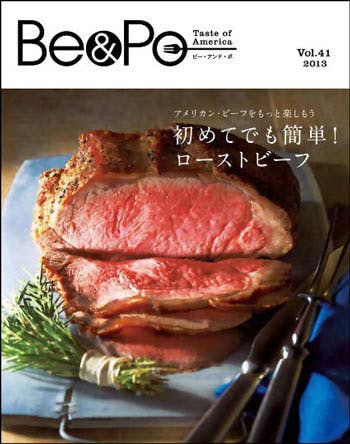USMEF-Japan’s Consumer Magazine Goes Digital
Published: Jul 16, 2013

Initially targeted at homemakers, the main decision-makers regarding meat purchases at retail, the full-color publication debuted in March 2003. It delivers feature articles on nutrition, product safety, American food cultures and trends, along with messages from American producers. In recent years, the audience has expanded to include more single men, particularly those who recognize that tasty, low-fat U.S. pork and lean American beef are an important part of a healthy diet.
The magazine also has helped spread awareness of and appreciation for U.S. beef and pork to an influential group of readers. Through Be&Po, USMEF has introduced more than 1,600 recipes using American beef and pork products developed by famous cooking instructors, well-known chefs and nutritionists. Many of these professionals subsequently began using American beef and pork at their cooking schools and restaurants.
In recognition of the increasing movement of Japanese consumers to digital media, USMEF recently took the decade-old publication digital, both to reach readers on their home computers and hand-held devices as well as to reduce production and distribution costs. Limited hard-copy distribution will continue at consumer seminars, supermarkets, restaurants and retail to reach new readers.”
“We have a very loyal reader base,” said Tazuko Hijikata, USMEF-Japan senior manager of consumer affairs. “USMEF receives hundreds of opinion cards that we insert into each issue of Be&Po (which stands for Beef & Pork), even though readers have to buy stamps to return the cards. We’ve made good use of that feedback to tailor the magazine to better serve our readers.
“Because of its quality content and sophisticated design, many retailers, hotels and foodservice companies often ask USMEF to provide Be&Po for their promotions and to allow them use the recipes introduced in the magazine,” said Hijikata.
The magazine also has helped spread awareness of and appreciation for U.S. beef and pork to an influential group of readers. Through Be&Po, USMEF has introduced more than 1,600 recipes using American beef and pork products developed by famous cooking instructors, well-known chefs and nutritionists. Many of these professionals subsequently began using American beef and pork at their cooking schools and restaurants.
In recognition of the increasing movement of Japanese consumers to digital media, USMEF recently took the decade-old publication digital, both to reach readers on their home computers and hand-held devices as well as to reduce production and distribution costs. Limited hard-copy distribution will continue at consumer seminars, supermarkets, restaurants and retail to reach new readers.”
“We have a very loyal reader base,” said Tazuko Hijikata, USMEF-Japan senior manager of consumer affairs. “USMEF receives hundreds of opinion cards that we insert into each issue of Be&Po (which stands for Beef & Pork), even though readers have to buy stamps to return the cards. We’ve made good use of that feedback to tailor the magazine to better serve our readers.
“Because of its quality content and sophisticated design, many retailers, hotels and foodservice companies often ask USMEF to provide Be&Po for their promotions and to allow them use the recipes introduced in the magazine,” said Hijikata.

The new digital format also will allow subscribers to pass the publication along to friends and family via email, significantly expanding distribution and word-of-mouth support.
Already, feedback to the change has been very positive. USMEF has received several hundred messages from readers including the following:
- “Before reading Be&Po, I didn’t trust non-domestic meat products, but now I always prefer American beef and pork at supermarkets. Thank you so much.”
- “Through Be&Po, I better understand the quality and safety of American meat products.”
- “Every time when I receive Be&Po, I tried new recipes using American meat and enjoyed them with my family. I really appreciate it.”
“Be&Po is an important communication tool with Japanese consumers as well as a resource of tips for activity planning,” added Hijikata. “Japanese consumers prefer so-called ‘story products.’ They want to know the background, history and producers of the products, and that’s why Be&Po has received such warm responses and strong support.”
The latest issue of Be&Po can be found here. An index of Be&Po publications can be found on the USMEF-Japan website.
